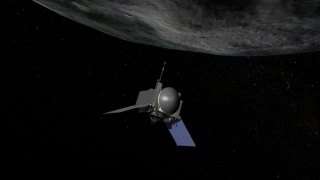NASA In Brief -- Asteroid mission spacecraft gets go-ahead

The decision was made April 9 after a successful design review for NASA’s Origins Spectral Interpretation Resource Identification Security Regolith Explorer -- OSIRIS-REx.
The spacecraft is scheduled to launch in the fall of 2016, rendezvous with the asteroid Bennu in 2018 and return with a sample in 2023. After more than a year of asteroid reconnaissance, OSIRIS-REx will collect samples of at least 2 ounces (60 grams) and return them to Earth for scientists to study.
Mission objectives include finding answers to questions about the composition of the very early solar system and the source of organic materials and water that made life possible on Earth. The mission will also aid NASA’s efforts to understand the population of potentially hazardous near-Earth objects and characterize those suitable for future asteroid exploration.
In January, NASA invited people around the world to submit their names to be etched on a microchip aboard the spacecraft. Participants are able to download and print a certificate documenting their participation in the OSIRIS-REx mission. The campaign is open until Sept. 30, 2014. Read more about it here.
ALTERNATIVE FUELS STUDIED: NASA has signed separate agreements with the German Aerospace Center (DLR) and the National Research Council of Canada (NRC) for joint flight tests to study the atmospheric effects of emissions from jet engines burning alternative fuels.
The Alternative Fuel Effects on Contrails and Cruise Emissions (ACCESS II) flights are set to begin May 7 and will be flown from NASA's Armstrong Flight Research Center in Edwards, Calif.
NASA's DC-8 and HU-25C Guardian, DLR's Falcon 20-E5 and NRC's CT-133 research aircraft will conduct flight tests in which the DC-8's engines will burn a mix of fuel blends, while the Falcon and CT-133 measure emissions and observe contrail formation.
Understanding the impacts of alternative fuel use in aviation could enable widespread use of one or more substitutes to fossil fuels as these new fuels become readily available and competitive in cost with conventional jet fuels.
Related:
NASA's asteroid plans: A primer

